CARTESIAN OVAL

| next curve | previous curve | 2D curves | 3D curves | surfaces | fractals | polyhedra |
CARTESIAN OVAL

| Curve studied by Descartes in 1637 (Géométrie,
p. 352 and following), Newton in 1687 (principia
mathematica book 1), Quetelet in 1827 (correspondance
mathématique t. V), Chasles, and Christoph Soland
in 1997 [Courbes
cartésiennes, thèse
de doctorat, université de Lausanne].
René Descartes (1596-1650): French philosopher, mathematician and physicist. Other names: aplanatic curve, optoïd. Exam paper. |
A Cartesian oval is the locus of the points M for
which the distances MF and MF' to two fixed points satisfy
a relation of the type: ,
with
(the
limit cases of the ellipse and the hyperbola are therefore excluded).
Remark: the curve is not empty iff
and
.
Find above a mechanical construction of the Cartesian
oval, in the case where v/u = 2, construction the can be generalised
(theoretically), on the condition to wrap the wire around the pulleys enough,
to the cases where v/u is a nonnegative rational. On the right,
the illustration is due to Descartes himself.
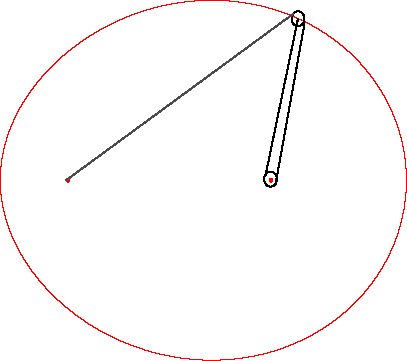 |
|
| Another mechanical construction, due to J. Hammond (1878).
The two pulleys are integral, their common axis has an
arbitrary position in the plane of the figure, only the ratio of their
radius equal to v/u matters. Once the foci have been chosen, two threads
are wound, in opposite directions, on the pulleys. The tip of the pencil,
fixed relative to the wire, is attached to the other end of each of the
two wires.
|
 |
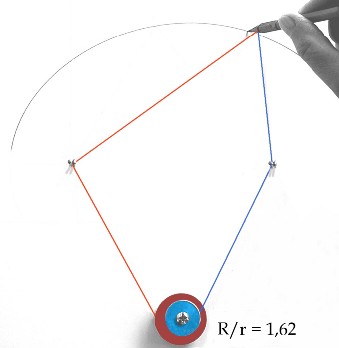 |
| A construction in space: the Cartesian ovals are the
projections of the intersections between two cones
of revolution with parallel axes on a plane perpendicular to these
axes (Quételet theorem).
More precisely, the cone On the right, geometric proof, for cones with vertices S and S' and half angles a and a': |
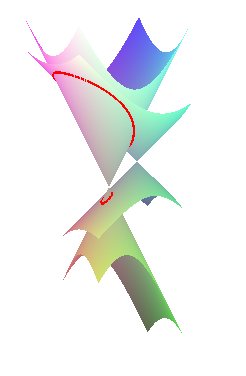 |
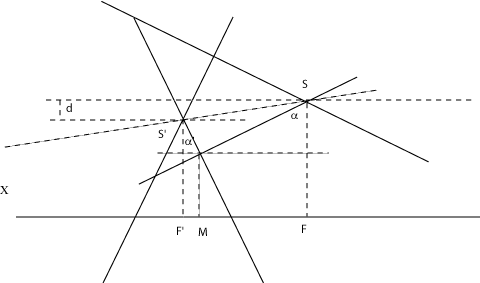 |
| This construction is the source of a planar construction,
due to Chasles, whose 3D origin can be forgotten. Cut the two cones by
a plane (P0) perpendicular to the
axes. This gives two circles (C) and (C') with centres F
et F'; the line joining the vertices S and S' of the
two cones cuts (P0) at the point
X,
and X, F, and F' are aligned. Any plane (P)
passing by F and F' cuts (P0)
on a line (D) passing by X. This plane (P) cuts the
two cones along two generatrices, which themselves intersect at a point
in the intersection of the two cones. When projecting, the line joining
F
to an intersection point between (C) and (D) and the line
joining F' to an intersection point between (C') and (D)
intersect at a point M on the Cartesian oval, projection of the
intersection of the two cones (and since there are two intersection points
for each circle, this constructs 4 points M).
When the line (D) turns around X, each of
the 4 points M describes a half Cartesian oval.
|
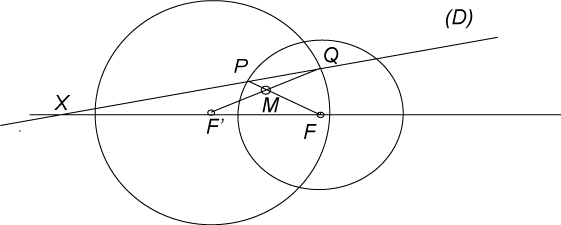 Proof without the space: the Menelaus theorem in the triangle MFF'
|
| Given two circles (C) and (C') with centres
F
and F' and radii R and R' greater than or equal to
FF',
we get the Cartesian oval Proof: Using Thales' theorem, we have MF.MF' = MN. MN'=(R'-MF')(R-MF) hence R' MF +R MF' = RR'. We get this way all the non-empty ovals |
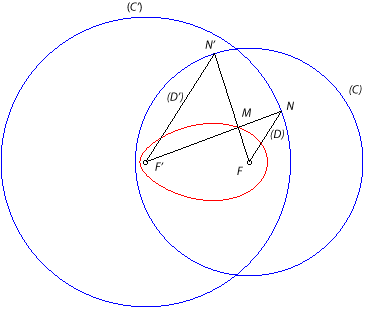 |
| If we follow the previous construction but take the intersection
points N between (D) and (C') and N'' of (D')
and (C) on either sides of (FF'), the intersection
point M' between (FN" and (F'N) describes now the
conjugate
Cartesian oval to the previous one, with equation Proof: Using Thales' theorem, we have M'F.M'F' = M'N. M'N"=(R'+M'F')(-R+M'F)
hence R' M'F -R M'F' = RR'.
|
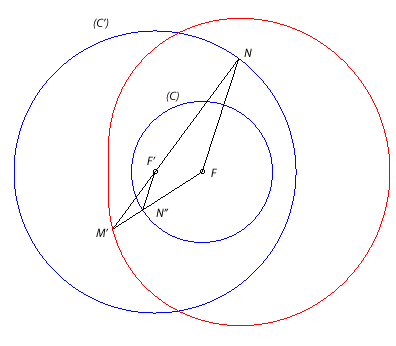 |
| With R = 2a, R'=2b,
F=(0,c),
F'=(–
c,0),
the construction above gives the following parametrizations
of the ovals Remark: the case R and R' > FF' studied here corresponds to that where the two foci are inside the oval; the other cases give the third focus (see after). |
| The tangent at M to the oval is orthogonal to
the vector Then, if From this we deduce the property that motivated the study of these curves by Descartes: if the external part of a Cartesian oval containing F has a refraction index n1 and the internal part containing F' has an index n2, with This property can also be found by using that the optical path length |
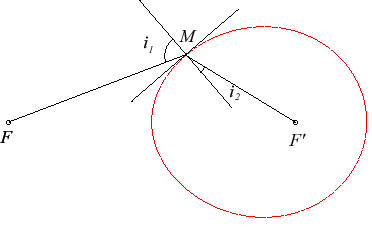
Figure with the oval MF+3MF'=2FF'. Therefore, here, |
More generally, the caustic by refraction of the oval for the light source F and the ratio u/v is the focus F': the Cartesian ovals are the curves for which a caustic by refraction is reduced to a point.
The associated complete Cartesian oval is the set
with bifocal equation: .
Among the four curves obtained by these double signs,
only two are not empty, and theese two ovals are said to be conjugate.
It can be proved that the Cartesian oval has a third
focus, aligned with the first two, such that the bifocal equations with
the two new couples of foci are still of the same type.
These relations between these foci and the equation are
given below. The foci are renamed "A, B, C", to correspond
to . These
are the notations we will use from now on.
| If Equivalent bifocal equations of the external oval: Equivalent bifocal equations of the internal oval: For the oval |
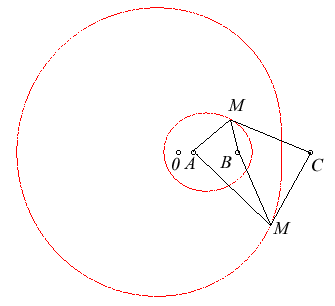 |
| Animation in the case where |
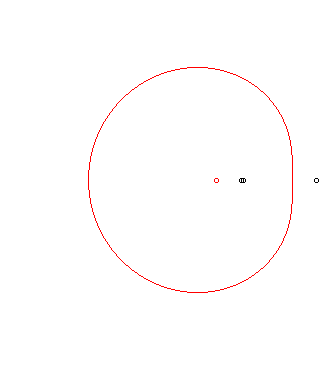 |
| Cartesian equation of the complete oval in the frame Abscissas of the 4 vertices: Polar equation of the complete oval in the frame |
The polar equation
shows that complete Cartesian ovals are anallagmatic:
they are the cyclic curves with initial
curve a circle. In other words, they are Cartesian
curves. More precisely, they are the Cartesian curves for which the
three real foci are aligned.
For the focus A, the initial circle is the circle
with centre O and radius
where
, the
directrix circle, the circle with centre A and radius
(for the other two foci, the definitions are obtained by permutation).
When the three foci are different points, the oval is called true oval. It then has three different cyclic definitions:
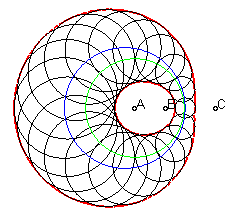 |
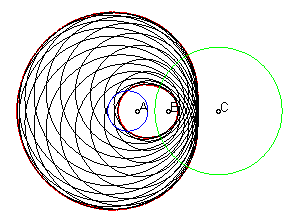 |
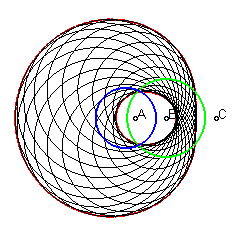 |
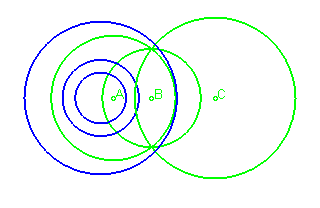
When the 3 foci coincide (),
the oval is a cardioid (but it
loses its bifocal definitions).
When only two of the three foci coincide, we get a limaçon
of Pascal:
- when A = B,
we get the elliptic limaçon:
(in
),
with bifocal equation:
,
which has two cyclic generations, among which only one has a zero power.
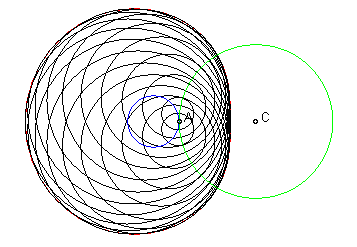 |
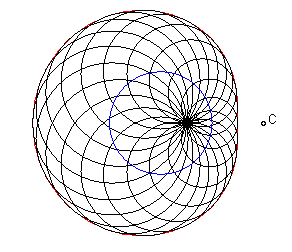 |
- when B = C, we get the hyperbolic
limaçon:
(in
),
with bifocal equation
for the external loop, and
for the internal loop, which has two cyclic generations, among which only
one has a zero power.
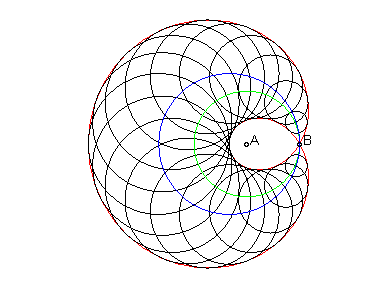 |
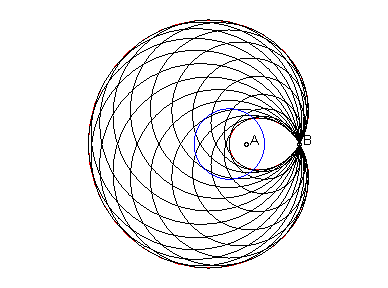
generation with zero power (circles passing by B and centred on the initial circle) |
The complete Cartesian ovals can also be defined as the anticaustics of circles (the limaçons of Pascal being obtained when the light source is on the circle). The evolute of complete Cartesian ovals are therefore caustics by refraction of circles.
Here are the geometrical loci that give Cartesian ovals:
1) Locus of a point for which the "algebraic distances"
to two fixed circles with different radii have a constant ratio different
from ± 1 (in which case we would get the bifocal conics). The "algebraic
distance" of a point to a circle is its distance to the centre minus the
radius. The Cartesian ovals are therefore the dividing
lines of two circles.
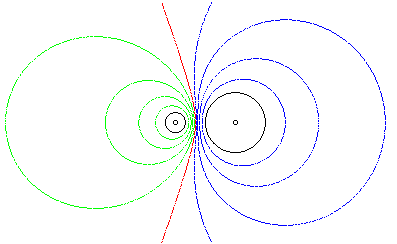 |
Dividing lines of two circles, defined by |
2) Given 3 aligned points F, G, H, locus of the vertex M of a triangle LMN such that the sides (NM), (ML), (LN) contain, respectively, F,G,H, when [ML] and [MN] have given fixed lengths (apply Menelaus theorem in the triangle MFG).
The Cartesian ovals are also found in the Bélidor drawbridge curve.
Another property of these very rich curves: the images of the lines parallel to the axes by an elliptic function P of Weierstrass with real period w1 and imaginary period w2 are Cartesian ovals.
| next curve | previous curve | 2D curves | 3D curves | surfaces | fractals | polyhedra |
© Robert FERRÉOL
2023